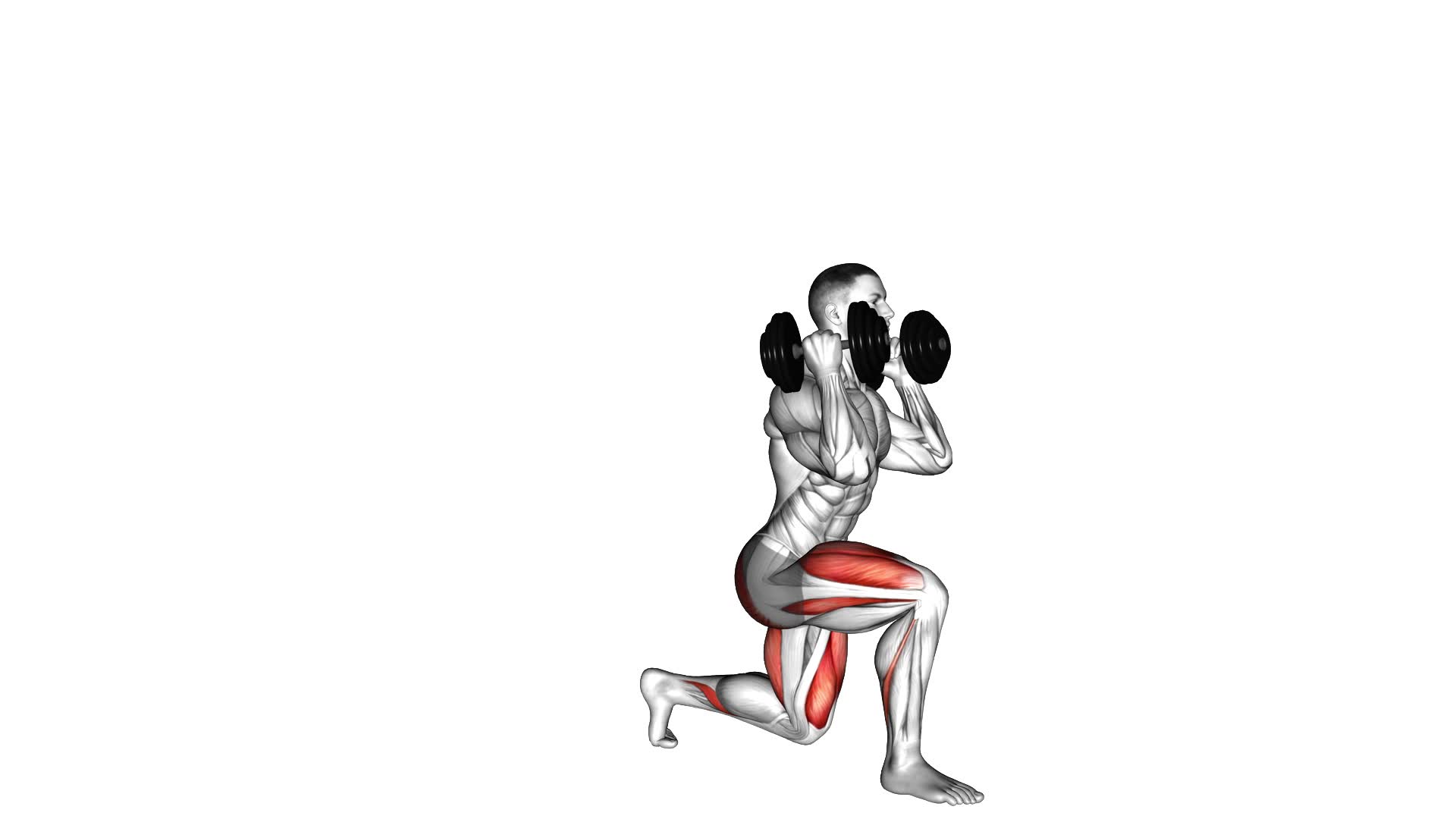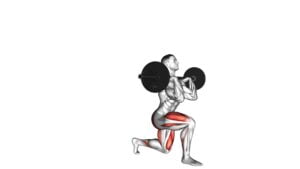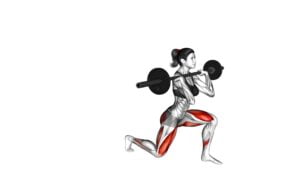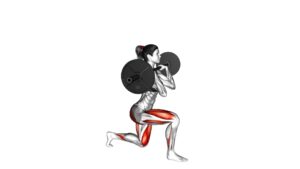Dumbbell Front Rack Lunge – Video Exercise Guide & Tips

Looking to amp up your leg workout?
Watch This Exercise Video
The dumbbell front rack lunge is a powerful exercise that targets your quads, glutes, and hamstrings all at once.
In this video exercise guide, we'll show you the proper form and technique for maximum results.
Whether you're a beginner or a seasoned fitness enthusiast, we'll help you choose the right dumbbells for your level.
Avoid common mistakes and discover tips for increasing the intensity of your lunge.
Get ready to take your leg day to the next level!
Key Takeaways
- The dumbbell front rack lunge targets multiple muscle groups, including quads, glutes, hamstrings, and core.
- Proper form and technique, such as maintaining an upright posture and stepping far enough forward, are crucial for maximizing the benefits and avoiding common mistakes.
- Choosing the right dumbbells for your fitness level, starting lighter for beginners and progressing gradually for advanced individuals, is important for safety and effectiveness.
- Tips for increasing the intensity of the lunge include incorporating additional weight or resistance, modifying the range of motion, trying advanced variations, and listening to your body's pace of progression.
Benefits of the Dumbbell Front Rack Lunge
You can experience a variety of benefits from incorporating the dumbbell front rack lunge into your workout routine. This exercise targets multiple muscle groups, including your quadriceps, hamstrings, glutes, and core. By working these muscles, you can improve your lower body strength, stability, and overall athleticism.
One of the key benefits of the dumbbell front rack lunge is that it allows for a wide range of variations. You can perform walking lunges, reverse lunges, or stationary lunges to challenge your muscles in different ways. By changing the direction or adding weight, you can continue to progress and avoid plateaus in your training.
To ensure proper form during the dumbbell front rack lunge, there are a few important tips to keep in mind. First, maintain an upright posture with your chest lifted and shoulders back. This will help engage your core and prevent strain on your lower back. Second, take a long step forward, ensuring that your knee tracks over your ankle and doesn't go past your toes. Lastly, push through your front heel as you stand back up, driving the weight through your quadriceps and glutes.
Incorporating dumbbell front rack lunges into your workout routine can lead to improved lower body strength, stability, and mobility. By utilizing different variations and maintaining proper form, you can maximize the benefits of this exercise and continue to progress in your fitness journey.
Proper Form and Technique for the Exercise
To ensure you perform the dumbbell front rack lunge with proper form and technique, it's important to avoid common mistakes.
These include not keeping your core engaged, not maintaining an upright posture, and not stepping far enough forward during the lunge.
Common Mistakes to Avoid
When performing the dumbbell front rack lunge, be mindful of the common mistakes that can hinder proper form and technique.
One mistake to avoid is allowing your knee to extend too far past your toes during the lunge. This puts excessive strain on the knee joint and can lead to injury.
Another mistake isn't maintaining a straight back throughout the movement. Rounded shoulders or a hunched posture can compromise the effectiveness of the exercise and increase the risk of back pain.
Additionally, make sure to keep your core engaged and your torso upright to maximize the benefits of the exercise.
Benefits of Proper Form
By maintaining proper form and technique during the dumbbell front rack lunge, you can maximize the benefits of this exercise and minimize the risk of injury.
One of the key benefits of performing the dumbbell front rack lunge with proper form is improved balance. This exercise requires you to stabilize your core and engage your muscles throughout the movement, helping to enhance your overall balance and stability.
Additionally, proper form ensures optimal muscle activation. By keeping your chest up, shoulders back, and knees aligned with your toes, you can effectively target the muscles in your legs, including your quadriceps, hamstrings, and glutes. This not only helps to build strength, but also promotes muscle activation and growth.
Choosing the Right Dumbbells for Your Fitness Level
When choosing dumbbells for your fitness level, it's important to consider the appropriate weight for beginners and the progression options for advanced individuals.
Beginners should start with lighter weights to focus on proper form and reduce the risk of injury.
Advanced individuals can increase the weight to challenge their muscles and continue to make progress.
Additionally, adjustable dumbbells provide the benefit of easily adjusting the weight to meet your changing fitness needs.
Weight for Beginners
You should choose dumbbells that are suitable for your fitness level.
As a beginner, it's important to start with lighter weights to focus on proper technique and avoid injury. Using weights that are too heavy can lead to poor form and strain on your muscles and joints.
Begin with a weight that allows you to complete the exercises with proper form and without compromising your stability. Gradually increase the weight as you become more comfortable and confident with the exercises.
It's better to start lighter and progress gradually rather than starting too heavy and risking injury. Remember, the goal is to build strength and endurance safely and effectively.
Progression Options for Advanced
As you progress in your fitness journey, it's important to choose dumbbells that challenge your strength and endurance while still allowing you to maintain proper form and stability. Here are some progression options and advanced variations to consider:
- Increase weight gradually: Gradually increase the weight of your dumbbells as you become stronger. This will continue to challenge your muscles and promote growth.
- Incorporate unilateral exercises: Instead of using two dumbbells, try performing exercises with a single dumbbell. This will require more stability and coordination, providing an extra challenge.
- Add explosive movements: Incorporate explosive movements like dumbbell snatches or clean and jerks. These dynamic exercises not only challenge your strength but also improve power and coordination.
- Use different grip variations: Experiment with different grip variations such as neutral grip, hammer grip, or offset grip. This will engage different muscle groups and add variety to your workouts.
By incorporating these progression options and advanced variations, you can continue to push yourself and take your fitness to the next level.
Now, let's explore the benefits of adjustable dumbbells.
Benefits of Adjustable Dumbbells?
As you progress in your fitness journey and consider the benefits of adjustable dumbbells, it's important to choose the right dumbbells for your fitness level to maximize your strength and endurance gains. When comparing adjustable dumbbells to traditional dumbbells, the versatility of adjustable dumbbells becomes evident. With adjustable dumbbells, you have the ability to change the weight according to your specific needs and goals, allowing for a more customized workout experience.
This flexibility is especially beneficial for individuals at different fitness levels, as it allows for gradual progression and accommodates increasing strength over time. By choosing the right dumbbells for your fitness level, you can ensure that you're challenging yourself appropriately while also reducing the risk of injury.
Now, let's explore some common mistakes to avoid during the front rack lunge.
Common Mistakes to Avoid During the Front Rack Lunge
To prevent common mistakes during the front rack lunge, make sure to keep the dumbbells securely resting on your shoulders and maintain proper form throughout the exercise. Here are some common mistakes to avoid when performing this exercise:
- Leaning too far forward: This can put excessive strain on your lower back and compromise your balance. Instead, keep your torso upright and engage your core to maintain stability.
- Allowing your knees to cave in: Allowing your knees to collapse inward can put stress on your knees and increase the risk of injury. Focus on keeping your knees in line with your toes throughout the movement.
- Taking too large of a step: Taking too large of a step can make it difficult to maintain proper form and control. Opt for a shorter stride to ensure stability and control throughout the exercise.
- Neglecting proper breathing: Proper breathing is essential during any exercise. Remember to inhale as you lower into the lunge and exhale as you push back up. This helps stabilize your core and improve overall performance.
By avoiding these common mistakes and maintaining proper form, you can maximize the effectiveness of your front rack lunges and reduce the risk of injury.
Now, let's move on to some tips for increasing the intensity of your lunge.
Tips for Increasing the Intensity of Your Lunge
To increase the intensity of your lunge, you can incorporate additional weight or modify the range of motion. Increasing intensity in your lunge can help challenge your muscles and improve your overall strength and stability.
One way to increase the intensity is by using dumbbells or kettlebells to add extra resistance. Hold the weights in each hand, either at your sides or in a front rack position, and perform the lunge as usual. This added weight will make your muscles work harder and increase the difficulty of the exercise.
Another way to increase the intensity is by modifying the range of motion. Instead of performing a regular lunge where your back knee almost touches the ground, you can try a deep lunge where your back knee does touch the ground. This increases the range of motion and requires more strength and stability.
Additionally, you can incorporate variations for advanced lunges. This can include performing walking lunges, jumping lunges, or adding a twist or rotation to the movement. These variations challenge your muscles in different ways and help to increase the intensity of your lunge workout.
Remember to always listen to your body and progress at a pace that's appropriate for your fitness level.
Sample Workout Routine Incorporating the Dumbbell Front Rack Lunge
Are you ready to incorporate the dumbbell front rack lunge into your workout routine? This exercise is a great way to target your lower body muscles while also improving your balance and stability.
To help you get started, here is a sample workout routine that incorporates the dumbbell front rack lunge progression:
- Warm-up: Begin with a dynamic warm-up to prepare your muscles for the workout. This can include exercises like leg swings, hip circles, and walking lunges.
- Dumbbell Front Rack Lunge: Start with lighter dumbbells and perform 3 sets of 8-10 reps on each leg. Focus on maintaining proper form, keeping your chest up and core engaged throughout the movement.
- Superset: Pair the dumbbell front rack lunge with an upper body exercise like push-ups or dumbbell rows. Perform 3 sets of 10-12 reps for each exercise, alternating between the two.
- Core Work: Finish your workout with some core exercises such as planks or Russian twists. Aim for 2-3 sets of 12-15 reps for each exercise.
Remember to gradually increase the weights and difficulty of the exercises as you progress. This sample workout routine will help you incorporate the dumbbell front rack lunge into your fitness regimen and achieve your lower body strength and stability goals.
Frequently Asked Questions
How Many Calories Does the Dumbbell Front Rack Lunge Burn?
The dumbbell front rack lunge is a great exercise for burning calories and improving overall strength and stability. By incorporating dumbbells into the exercise, you increase the resistance and therefore the calorie burn.
To perform the exercise with proper form, ensure that your front knee stays aligned with your ankle and your back knee gently touches the ground. Remember to engage your core and keep your chest lifted throughout the movement.
Can I Do the Dumbbell Front Rack Lunge if I Have Knee or Back Problems?
If you have knee or back problems, modifications can be made to the dumbbell front rack lunge to accommodate your needs. It's important to consult with a professional, such as a physical therapist or trainer, to determine the best modifications for you.
Despite potential modifications, the dumbbell front rack lunge can still provide benefits for muscle strength, particularly in your legs, glutes, and core.
How Does the Dumbbell Front Rack Lunge Compare to Other Lunge Variations?
The dumbbell front rack lunge offers a variety of benefits compared to other lunge variations. It targets your leg muscles, improves balance, and increases core stability.
Unlike other lunges, the dumbbell front rack lunge places the weights in front of your body, which engages your upper body muscles as well.
This exercise also helps to improve your posture and overall strength.
Incorporating different variations of the dumbbell front rack lunge can add variety to your workouts and challenge your muscles in different ways.
Can the Dumbbell Front Rack Lunge Help Improve My Balance and Stability?
Improving your balance and stability is crucial for overall fitness.
The dumbbell front rack lunge can definitely help you achieve that. By holding the dumbbells in front of your body, you're challenging your core and lower body muscles to work together in order to maintain proper form and balance.
This exercise targets your quads, glutes, and hamstrings while also engaging your core.
Adding the dumbbell front rack lunge to your routine can enhance your balance and stability.
Is It Necessary to Warm up Before Performing the Dumbbell Front Rack Lunge?
Before performing the dumbbell front rack lunge, it's necessary to warm up.
Warming up helps prepare your body for exercise by increasing blood flow, loosening up your muscles, and reducing the risk of injury.
Some alternative warm-up exercises you can consider include jogging in place, jumping jacks, or dynamic stretches.
Incorporating a warm-up routine into your workout can enhance your performance and overall workout experience.
Conclusion
Incorporating the dumbbell front rack lunge into your workout routine can offer numerous benefits such as improved leg strength, balance, and core stability. By maintaining proper form and technique, choosing the appropriate dumbbell weight, and avoiding common mistakes, you can maximize the effectiveness of this exercise.
Additionally, by following the provided tips for increasing intensity and incorporating it into a sample workout routine, you can take your lunges to the next level and achieve your fitness goals.

Author
Years ago, the spark of my life’s passion ignited in my mind the moment I stepped into the local gym for the first time. The inaugural bead of perspiration, the initial endeavor, the very first surge of endorphins, and a sense of pride that washed over me post-workout marked the beginning of my deep-seated interest in strength sports, fitness, and sports nutrition. This very curiosity blossomed rapidly into a profound fascination, propelling me to earn a Master’s degree in Physical Education from the Academy of Physical Education in Krakow, followed by a Sports Manager diploma from the Jagiellonian University. My journey of growth led me to gain more specialized qualifications, such as being a certified personal trainer with a focus on sports dietetics, a lifeguard, and an instructor for wellness and corrective gymnastics. Theoretical knowledge paired seamlessly with practical experience, reinforcing my belief that the transformation of individuals under my guidance was also a reflection of my personal growth. This belief holds true even today. Each day, I strive to push the boundaries and explore new realms. These realms gently elevate me to greater heights. The unique combination of passion for my field and the continuous quest for growth fuels my drive to break new ground.







